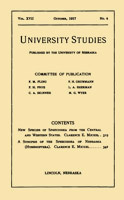University Studies of the University of Nebraska
Date of this Version
8-1954
Citation
University of Nebraska Studies, new series no. 12, August 1954
Abstract
T HE present study developed out of a desire to understand the character of liberalism and conservatism in Prussia on the eve of German unification. Who were the liberals? Who were the Conservatives? What were their ideals and how did they conduct themselves in public? How powerful was each group in the state? In conflict throughout the Nineteenth Century, the opponents reached the peak of their antagonism in the years between 1858 and 1866, the the years of the New Era, the constitutional conflict, and the first two wars of German unification. Fundamental social, economic, and political ideals were at stake. One group would have aligned the country with the West; the other sought to preserve the Old Regime. Since the story of Bismarck's crushing defeat of the liberals by his Realpolitik after 1864 is well known, the present analysis concentrates upon the internal crisis of 1858 to 1864 within Prussia; and in keeping with the nature of the subject, the method of treatment is topical rather than chronological. Analyses of social and institutional forces in conflict in the past century and a half should be made for each of the European countries. The Old Regime survived over much of the continent well into the Twentieth Century, and controversies like the one in Prussia occurred in every state. The present study can be justified not merely as a treatment of a crucial period in German history but as an essential chapter in the history of modern Europe. It should help toward making possible a comparative analysis of society and institutions in the modern world, by means of which we should, for example, be able to explain the remarkable difference between the course of development of Europe and that of the United States.
IN 1858 King Frederick William IV of Prussia became mentally deranged and had to relinquish the royal authority to his brother, Prince William. The Regent quickly ousted most of the Conservatives in the ministry and appointed right-wing liberals in their stead. The people of Prussia interpreted the Regent's words and actions as an indication of liberalism. In the elections to the Lower House of the Landtag in the next year they threw out the Conservative majority in favor of the liberals. During the course of the next three years, popularly called the New Era because of the hope for the liberal refornl of Prussia and the national unification of Germany, the ruler and the liberal majority learned to their dismay that each wished something different from the other. The former harbored two aims, to reform and strengthen the army and to keep his absolute power, while the latter was equally determined to reform Prussia in a liberal sense and to unify Germany. Both William and the liberals confused reality with desire. The Prince thought that he was governing a Prussia like that of his beloved father, Frederick William III (d. 1840), but actually he faced a state in which society had considerably altered. The liberals believed that the Regent appreciated the needs of the time and could be led or pushed into a movement of reform. Through initial misunderstanding and subsequent refusal to compromise they drifted by 1862 into a constitutional conflict. The ruler, who became King on the death of his brother in January, 1861, dismissed the liberal ministers in the next year, again turned to the Conservatives, and in September, 1862, appointed Bismarck as Minister President. The selection of this Junker statesman signified that the controversy over the meaning of the constitution would be resolved by Machtpolitik. In spite of the fact that the elections to the Lower House in 1861 and in 1862 had almost eliminated the Conservatives, the government, through the exercise of all possible pressure upon the voters, tried in 1863 to replace the overwhelming liberal majority by Conservatives. The attempt failed; but the King and his Conservative ministers continued to rule, and as a result of their successful resistance to the liberals they imparted to the constitution the absolutistic interpretation that they wished. Apparently so promising at the beginning of the New Era, liberalism went down to crushing defeat. How did the conflict between the liberals on the one hand and the King and the Conservatives on the other come about? An explanation involves, first, a portrayal of the ruler's character, second, a comparison between his aims and those of the liberals, and third, a summary of the economic and social changes that had occurred in Prussia since the formative years of the new ruler's youth.


Comments
(c) 1954 University of Nebraska